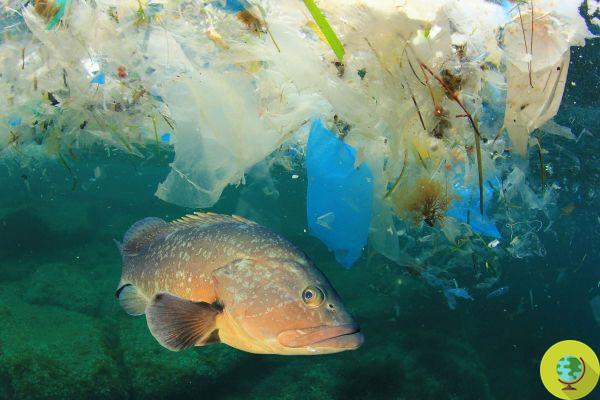
Over two-thirds of the fish species that ate plastic end up on our tables. A problem that concerns us close.
Many of the fish we bring to our tables feed on the plastic that ends up in the sea. And these are not exceptions, unfortunately it is now the rule. This is confirmed by a new study, the most complete ever carried out, which calculated for the first time how many species eat our garbage.
Plastic pollution has pervaded nearly every aspect of the biosphere. However, we do not yet have the exact measure of the risk of consumption by marine species on a global scale. To address this problem, the new study published in the journal Global Change Biology sought to document the ingestion of plastic debris by marine fish. In total, 171.774 creatures belonging to 555 species were examined. And the results are far from encouraging: 386 species of fish have ingested plastic debris, including 210 species of commercial importance.
Trillions of barely visible pieces of plastic float in the oceans of the world, from surface waters to the depths of the sea. These particles, known as microplastics, form when larger plastic objects such as shopping bags and food containers break.
Researchers are concerned about microplastics because they are so tiny, widely distributed, and easy for wildlife to ingest, accidentally or intentionally.
“We study marine science and animal behavior and wanted to understand the extent of this problem. In a recently published study we conducted with ecologist Elliott Hazen, we examined how marine fish, including species consumed by humans, are ingesting synthetic particles of all sizes, ”the authors explain in an article published in The Conversation. .
In the largest review of this topic to date, they have found not only that 386 species of marine fish have ingested plastic debris but that this unhealthy habit is on the rise.
Researchers at the Monterey Bay Aquarium in California have found microplastic particles from the surface to the sea floor, where they can be ingested by a wide range of marine creatures. Unfortunately, the problem has been known for some time. The first scientific observation of this problem came from the stomach of a seabird in 1969. Three years later, scientists reported that fish off the southern coast of New England were consuming tiny particles of plastic.
Since then, over 100 scientific articles have described the ingestion of plastic in numerous species of fish. But each study contributed only a small piece of a very important puzzle.
“To see the problem more clearly, we had to put those pieces together. We did this by creating the largest existing database on marine fish ingestion of plastic, drawing on all of the scientific studies of the problem published from 1972 to 2019. We gathered a range of information from each study, including the fish species examined. the number of fish that ate plastic and when those fish were caught, ”they continue.
Furthermore, for each species, the diet, habitat and eating behaviors were identified. Unfortunately, according to the scientists, the trends found were surprising and worrying:
“Our research revealed that marine fish ingest plastic around the world. According to the 129 scientific articles in our database, researchers have studied this problem in 555 species of fish around the world. We were alarmed to find that more than two-thirds of those species had ingested plastic. Our review of four decades of research indicates that fish plastic consumption is on the rise. From an international assessment conducted for the United Nations in 2016, the number of marine fish species found with plastic has quadrupled ”.
Looking at the last decade, the percentage of fish ingesting plastic has doubled across all species. According to scientists, the reasons are essentially two:
"We suppose this could happen both because the methods of detecting microplastics are improving and because the plastic pollution of the oceans continues to increase."
Fish such as sharks, groupers, and tuna that hunted other fish or marine organisms were more likely to ingest plastic. As a result, the species higher up the food chain were those at greatest risk.
Over two-thirds of the fish species that ate plastic end up on our tables. A problem that concerns us very closely.
Sources of reference: Global Change Biology, The Conversation,
READ also:
- Mussels, oysters and scallops are the seafood most contaminated with microplastics. I study
- Grilled scampi… in plastic: textile fibers and microplastics in the fish of the Cetacean Sanctuary. I study
- Microplastics have also reached human organs


























